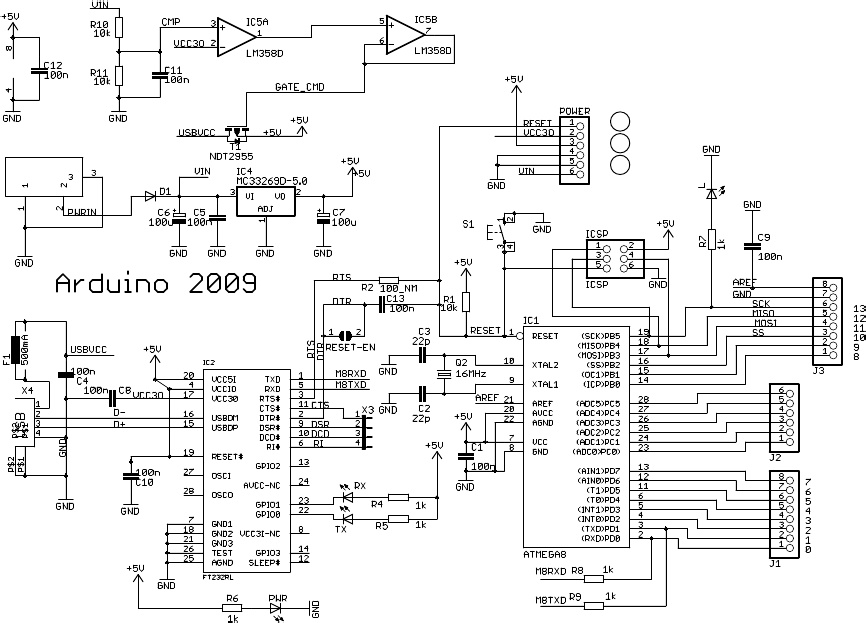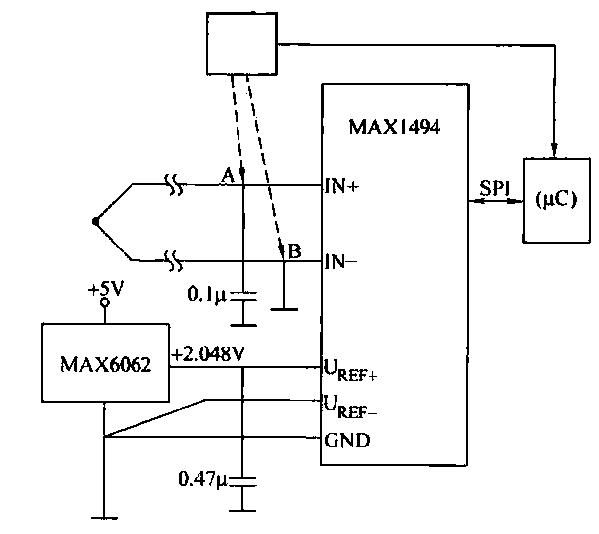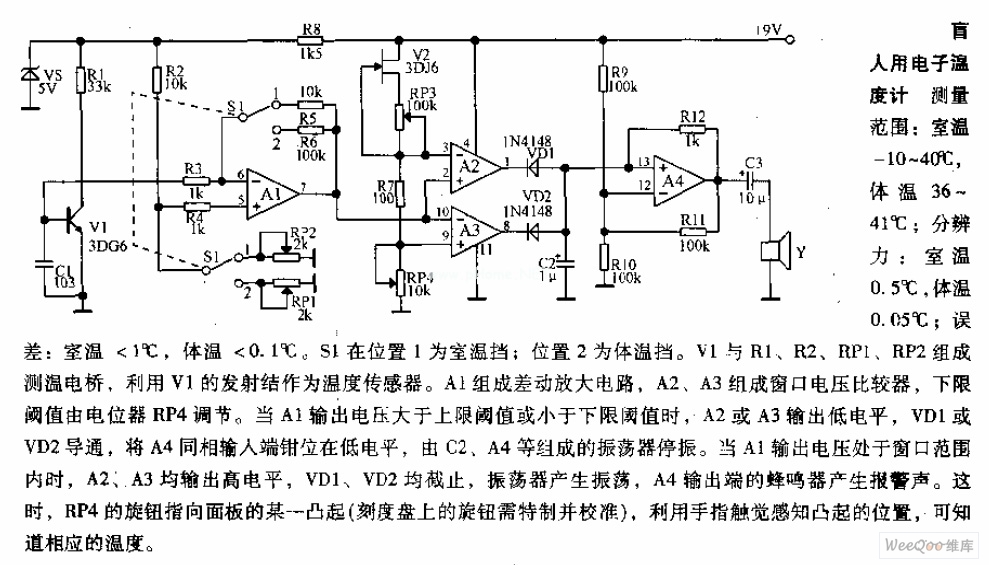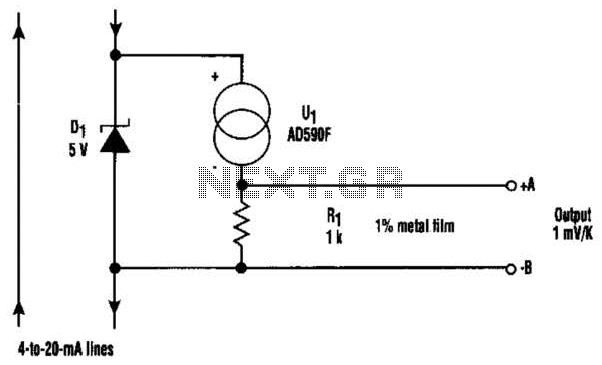
CVS Oral Thermometer Dissection
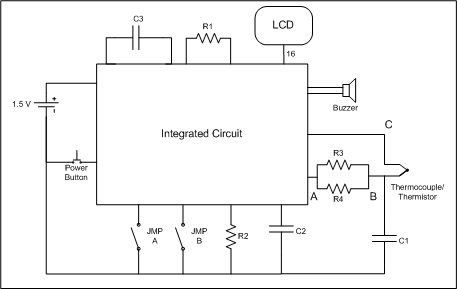
This straightforward high-level design illustrates the structure of the product. The integrated circuit reacts to button presses and detects temperature through a probe, displaying the temperature on an LCD and activating a buzzer upon completion. A more detailed diagram reveals that the temperature probe is part of a temperature measurement circuit. Additionally, there appears to be a normalizing reference circuit. This diagram also includes the unit-selection jumper, which is only visible on the PCB. The schematic highlights the relative simplicity of this thermometer circuit, with most functions managed internally by the IC. The thermal device operates in conjunction with resistors R3, R4, and capacitor C1 to form the temperature measurement circuit, with the variable thermal device influencing the circuit's time constant. The LCD is driven through a 16-bit bus, while the buzzer utilizes a two-wire interface for pulse transmission. The roles of R2, C2, and C3 are not immediately clear, but waveforms observed at R1 suggest that it acts as a reference circuit for normalizing temperature measurements. The jumpers (disconnected pads) A and B can be employed to switch the thermometer to Celsius.
The described thermometer circuit is designed for ease of use and functionality, integrating multiple components to create a compact and efficient temperature measurement system. The central element is the integrated circuit (IC), which handles the majority of the processing tasks. The temperature probe is critical for measuring ambient temperature, and it interfaces directly with the IC to relay temperature readings. The output is displayed on an LCD, which is controlled via a 16-bit bus, ensuring precise data representation.
The inclusion of a buzzer provides an audible indication when temperature measurement is complete, enhancing user interaction. The circuit also features a normalizing reference circuit, which stabilizes the temperature readings by compensating for variations in the measurement environment. This is particularly important in applications where accurate temperature measurement is crucial.
Resistors R3 and R4, along with capacitor C1, form a part of the thermal measurement circuit, where they work together to establish the time constant of the circuit. This time constant is influenced by the characteristics of the variable thermal device, which can change its properties based on temperature fluctuations.
The role of components R2, C2, and C3, while not explicitly defined, is likely related to filtering or signal conditioning, ensuring that the signals processed by the IC are clean and accurate. The jumpers A and B provide a user-configurable option to switch between Celsius and Fahrenheit, allowing for adaptability based on user preference or regional standards.
Overall, the design represents a well-thought-out approach to creating a user-friendly temperature measurement device, with careful consideration given to both functionality and ease of use.This very simple high-level design demonstrates the product`s structure. Its integrated circuit responds to button presses and senses temperature via the probe, displaying the temperature on the LCD and sounding the buzzer when finished. This more detailed diagram shows that the temperature probe is part of a temperature measurement circuit.
There is also what appears to be a normalizing referenc circuit. Finally, this diagram incorporates the unit-selection jumper only visible on the PCB. This schematic illustrates the relative simplicity of this thermometer circuit; most of the work is done inside the IC. The themal device works with R3, R4, and C1 to make a temperature measurement circuit, with the variable thermal device affecting the circuit`s time constant.
The LCD is driven via a 16-bit bus, and the buzzer has a two-wire interface for sending pulses. The operation of R2, C2, and C3 is unapparent, but the waveforms on R1 seem to suggest that it provides a reference circuit for normalizing temperature measurements. The jumpers (disconnected pads) A and B can be used to switch the thermometer into Celsius. 🔗 External reference
The described thermometer circuit is designed for ease of use and functionality, integrating multiple components to create a compact and efficient temperature measurement system. The central element is the integrated circuit (IC), which handles the majority of the processing tasks. The temperature probe is critical for measuring ambient temperature, and it interfaces directly with the IC to relay temperature readings. The output is displayed on an LCD, which is controlled via a 16-bit bus, ensuring precise data representation.
The inclusion of a buzzer provides an audible indication when temperature measurement is complete, enhancing user interaction. The circuit also features a normalizing reference circuit, which stabilizes the temperature readings by compensating for variations in the measurement environment. This is particularly important in applications where accurate temperature measurement is crucial.
Resistors R3 and R4, along with capacitor C1, form a part of the thermal measurement circuit, where they work together to establish the time constant of the circuit. This time constant is influenced by the characteristics of the variable thermal device, which can change its properties based on temperature fluctuations.
The role of components R2, C2, and C3, while not explicitly defined, is likely related to filtering or signal conditioning, ensuring that the signals processed by the IC are clean and accurate. The jumpers A and B provide a user-configurable option to switch between Celsius and Fahrenheit, allowing for adaptability based on user preference or regional standards.
Overall, the design represents a well-thought-out approach to creating a user-friendly temperature measurement device, with careful consideration given to both functionality and ease of use.This very simple high-level design demonstrates the product`s structure. Its integrated circuit responds to button presses and senses temperature via the probe, displaying the temperature on the LCD and sounding the buzzer when finished. This more detailed diagram shows that the temperature probe is part of a temperature measurement circuit.
There is also what appears to be a normalizing referenc circuit. Finally, this diagram incorporates the unit-selection jumper only visible on the PCB. This schematic illustrates the relative simplicity of this thermometer circuit; most of the work is done inside the IC. The themal device works with R3, R4, and C1 to make a temperature measurement circuit, with the variable thermal device affecting the circuit`s time constant.
The LCD is driven via a 16-bit bus, and the buzzer has a two-wire interface for sending pulses. The operation of R2, C2, and C3 is unapparent, but the waveforms on R1 seem to suggest that it provides a reference circuit for normalizing temperature measurements. The jumpers (disconnected pads) A and B can be used to switch the thermometer into Celsius. 🔗 External reference
Warning: include(partials/cookie-banner.php): Failed to open stream: Permission denied in /var/www/html/nextgr/view-circuit.php on line 713
Warning: include(): Failed opening 'partials/cookie-banner.php' for inclusion (include_path='.:/usr/share/php') in /var/www/html/nextgr/view-circuit.php on line 713

